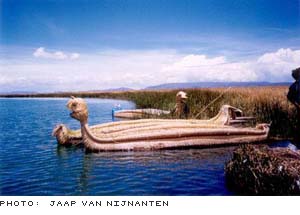|
At 3,827 meters above sea level, the Peruvian city of Puno is the highest lake port in the world. Puno is the capital city of the Province bearing the same name. It shares its altitude with over one dozen settlements around the Titicaca Lake on the border between Bolivia and Peru. Puno, Juliaca, Lampa, Desaguadero, Chucuito, Pucara, and Yunguyo on the Peruvian side, are twin cities to Copacabana, San Pedro de Tiquina, Challapampa, Ancoraimes, Puerto Acosta, and Guaqui on the Bolivian side.
According to people living there, they are the chosen. It was from the Titicaca Lake that Manco Capac and Mama Ocllo started their journey to create the Inca empire. Before that, 10,000 years ago, the Titicaca lake flourished with life irradiating its influence everywhere. Plans and animals were first domesticated there. Andean Camelidae, llamas, alpacas, and vicunas evolved there and it was the source of potatoes, the omnipresent staple food found in almost every regional meal in the world. You learn to use natural resources to their fullest. Take, for instance, the totora, a cattail used as food and as construction material for homes, rafts and canoes. It is also the structural foundation for the floating islands supplementing the landscape of the Andean lake. On these artificial lakes, the Uros live. They are the descendants of the first lake dwellers. As their ancestors, they have kept their customs and idiosyncrasies over the centuries.
The numberless natural islands are also full of tradition and legends. In Bolivia one of the most significant is the Island of the Sun and the Moon with ceremonies related to agricultural and fertility cycles. In Peru, Taquile and Amantani are especially noteworthy. On these islands, the indigenous dwellers speak no Spanish and practice a community work system. Before Christianity, the Titicaca had already seen civilizations bequeathed to them in the Pizacoma cave paintings in the archeological areas of Tiahuanaco, Pucara and Sillustani, among others. Today, “aymara”, the New Year, is celebrated on June 21 when the dawn sunbeams penetrate the Kalasasaya temple and lighten the Ponce’s monolith.
Colonial traditions are also found in town tracing, their churches and cathedrals. Regional celebrations, especially the Virgin of Candle-mass are still alive joining Bolivians and Peruvians with bonds as strong as those dreamed of by Simon Bolivar. Museums, monuments, sanctuaries, ruins, legends refusing to perish, everlasting traditions, ancient civilizations lasting for thousands of years. All of this fed by the generous sap of the Titicaca Lake on top of the Andes. The Titicaca Lake, an example of the best of the latin spirit. |
|
|
 Can
a port be at a higher altitude than 3,800 meters above the sea level?
Can
a port be at a higher altitude than 3,800 meters above the sea level?